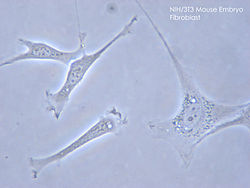Fibroblast Structure and Development
- Fibroblasts have a branched cytoplasm surrounding an elliptical, speckled nucleus.
- Active fibroblasts can be recognised by their abundant rough endoplasmic reticulum.
- Inactive fibroblasts (fibrocytes) are smaller, spindle-shaped, and have less rough endoplasmic reticulum.
- Fibroblasts can locally align in parallel clusters when crowded.
- Fibroblasts do not form flat monolayers like epithelial cells.
- Fibroblasts and fibrocytes are two states of the same cells.
- Fibroblasts are the activated state, while fibrocytes are the less active state.
- Ectopically transplanted fibroblasts can retain positional memory of their previous location.
- Morphologically inconspicuous fibroblasts can cause discomfort if they stagnate excessively.
- The suffix '-blast' denotes a stem cell or an activated state of metabolism.
- Fibroblasts maintain the structural integrity of connective tissues.
- They secrete precursors of the extracellular matrix, including ground substance and fibers.
- Fibroblasts are derived from primitive mesenchyme and express vimentin.
- Epithelial cells can give rise to fibroblasts through epithelial-mesenchymal transition (EMT).
- Fibroblasts can give rise to epithelia through mesenchymal to epithelial transition (MET).
Fibroblast Functions and Communication
- Fibroblasts make collagen fibers, glycosaminoglycans, reticular, and elastic fibers.
- They divide and synthesize ground substance in growing individuals.
- Tissue damage stimulates fibrocytes and induces the production of fibroblasts.
- Fibroblasts play a critical role in initiating inflammation in response to tissue injury.
- They regulate hematopoietic cells and provide a pathway for immune cells to regulate fibroblasts.
- Fibroblasts communicate with other cells through paracrine signaling.
- They can receive signals from neighboring cells and respond accordingly.
- Fibroblasts secrete cytokines and chemokines to attract immune cells to the site of injury.
- These cells can also interact with immune cells to modulate the immune response.
- Fibroblasts can communicate with endothelial cells to promote angiogenesis.
Fibroblasts in Disease and Pathology
- Abnormal fibroblast activity is associated with fibrosis, a condition characterised by excessive scar tissue formation.
- Fibroblasts play a role in the pathogenesis of various diseases, including cancer.
- Dysfunctional fibroblasts can contribute to chronic inflammation.
- Fibroblasts in the tumor microenvironment can promote tumor growth and metastasis.
- Targeting fibroblast activity is a potential therapeutic strategy for treating fibrotic diseases and cancer.
Fibroblasts in Stem Cell Culture
- Fibroblasts are commonly used as feeder cells in the culture of pluripotent stem cells.
- They provide essential nutrients and support for the growth of stem cells.
- Fibroblasts can be genetically modified to enhance their ability to support stem cell culture.
- Feeder layer cells, including fibroblasts, can influence the differentiation of stem cells.
- Fibroblast feeder cells have been used to promote the maturation of induced pluripotent stem cells into specific cell types.
Research and Advances in Fibroblast Biology
- Scientists are studying the role of fibroblasts in tissue regeneration and repair.
- Understanding fibroblast behavior is crucial for developing therapies for fibrotic diseases.
- Advances in culture systems have led to the development of xeno-free culture conditions for fibroblasts and stem cells.
- Fibroblasts are being investigated as potential targets for immunotherapy.
- Research is ongoing to uncover the mechanisms underlying fibroblast-mediated immune responses.
A fibroblast is a type of biological cell that synthesizes the extracellular matrix and collagen, produces the structural framework (stroma) for animal tissues, and plays a critical role in wound healing. Fibroblasts are the most common cells of connective tissue in animals.
| Fibroblast | |
|---|---|
 | |
| Details | |
| Location | Connective tissue |
| Function | Extracellular matrix and collagen creation |
| Identifiers | |
| Latin | fibroblastus |
| MeSH | D005347 |
| TH | H2.00.03.0.01002 |
| FMA | 63877 |
| Anatomical terms of microanatomy | |
fibro- + -blast
fibroblast (plural fibroblasts)
Borrowed from French
... Read More